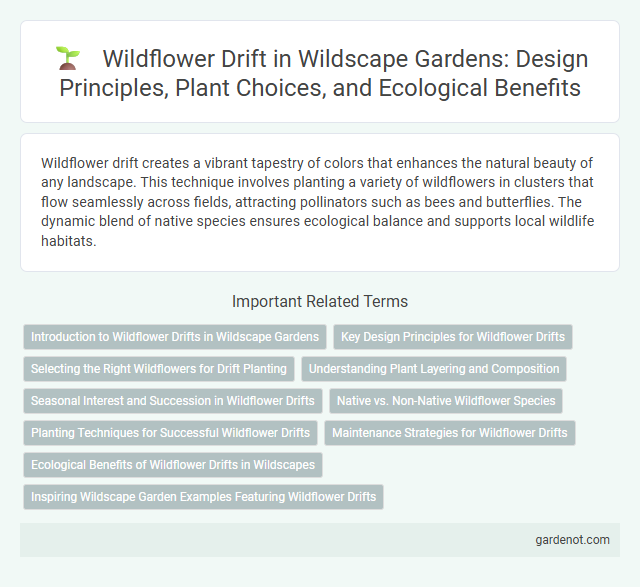Wildflower drift creates a vibrant tapestry of colors that enhances the natural beauty of any landscape. This technique involves planting a variety of wildflowers in clusters that flow seamlessly across fields, attracting pollinators such as bees and butterflies. The dynamic blend of native species ensures ecological balance and supports local wildlife habitats.
Introduction to Wildflower Drifts in Wildscape Gardens
Wildflower drifts in Wildscape Gardens create vibrant, naturalistic displays that enhance biodiversity and support pollinators like bees and butterflies. These carefully planned clusters blend native species such as coneflowers, black-eyed Susans, and purple asters to encourage ecological balance and seasonal beauty. Wildflower drifts also improve soil health and habitat connectivity, making them essential components of sustainable garden design.
Key Design Principles for Wildflower Drifts
Wildflower drifts emphasize biodiversity by incorporating native species that support local pollinators and wildlife, enhancing ecological resilience. Strategic layering of plant heights and bloom times ensures continuous visual interest and habitat availability throughout the seasons. Soil health and site conditions guide species selection, optimizing growth success and sustainability in naturalized landscapes.
Selecting the Right Wildflowers for Drift Planting
Choosing the right wildflowers for drift planting involves selecting species that naturally thrive in clusters and complement the surrounding ecosystem. Opt for native wildflowers such as purple coneflower, black-eyed Susan, and wild bergamot, which provide vibrant colors and support local pollinators. Proper soil preparation and consideration of bloom times ensure a dynamic, sustainable wildflower drift that enhances biodiversity.
Understanding Plant Layering and Composition
Wildflower drift demonstrates the intricate layering of native plant species, promoting biodiversity and ecological balance. By combining ground covers, mid-height perennials, and taller flowering plants, this technique mimics natural habitats and supports pollinators such as bees and butterflies. Optimal plant composition in wildflower drifts reduces soil erosion and enhances aesthetic appeal throughout the growing season.
Seasonal Interest and Succession in Wildflower Drifts
Wildflower drifts create dynamic seasonal interest by showcasing a continuous succession of blooms from early spring through late autumn, ensuring vibrant colors and varied textures throughout the growing season. Native species such as ox-eye daisy, cornflower, and poppy establish ecological resilience while attracting pollinators like bees and butterflies, enhancing biodiversity. Successional planting strategies promote soil health, reduce maintenance, and support a balanced ecosystem within wildflower habitats.
Native vs. Non-Native Wildflower Species
Wildflower drift significantly impacts the balance between native and non-native wildflower species within a wildscape, often causing non-native plants to spread beyond their intended areas and compete with indigenous flora. Native wildflowers provide essential habitat and food sources for local pollinators and wildlife, supporting ecological stability and biodiversity. Monitoring and managing wildflower drift helps maintain native plant dominance, promoting ecosystem resilience and preventing the displacement of valuable local species.
Planting Techniques for Successful Wildflower Drifts
Wildflower drift planting involves sowing a mix of native wildflower seeds in large, flowing swathes to create naturalistic landscapes that support biodiversity and pollinators. Optimal techniques include preparing well-drained, nutrient-poor soil to mimic wild conditions, using a seed mix tailored to local climate and soil, and scattering seeds evenly for dense, diverse growth. Timing sowing in early spring or autumn enhances germination rates, while minimal disturbance during establishment promotes robust wildflower communities.
Maintenance Strategies for Wildflower Drifts
Effective maintenance strategies for wildflower drifts include regular mowing to prevent the encroachment of grasses and invasive species, ideally timed after seed set to promote natural regeneration. Controlled burns or selective cutting can enhance biodiversity by mimicking natural disturbances, thereby encouraging native wildflower growth. Soil monitoring and targeted weed control further support the health and sustainability of wildflower drifts in diverse ecosystems.
Ecological Benefits of Wildflower Drifts in Wildscapes
Wildflower drifts enhance biodiversity by providing essential habitats and food sources for pollinators such as bees, butterflies, and birds within wildscapes. These continuous stretches of native wildflowers also improve soil health through natural nutrient cycling and erosion control. Incorporating wildflower drifts supports ecosystem resilience, promoting the regeneration of native plant species and fostering a balanced, thriving environment.
Inspiring Wildscape Garden Examples Featuring Wildflower Drifts
Wildflower drifts create vibrant, naturalistic displays that enhance biodiversity and attract pollinators like bees and butterflies, making them a key feature in inspiring wildscape gardens. By incorporating native species such as coneflowers, black-eyed Susans, and wild bergamot, these drifts mimic natural ecosystems and provide seasonal interest throughout the year. Strategic layering and grouping of wildflowers in sweeping drifts maximize ecological benefits while offering stunning visual impact.
Wildflower drift Infographic

 gardenot.com
gardenot.com